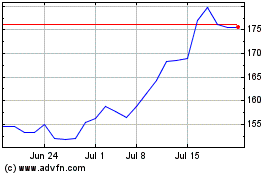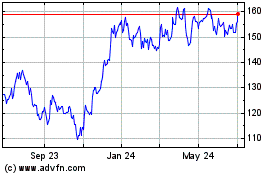PNC Will Be Regional No More -- Heard on the Street
November 16 2020 - 3:33PM
Dow Jones News
By Telis Demos
PNC Financial Services' acquisition of the BBVA franchise in the
U.S. would make its "regional bank" nametag increasingly obsolete.
The question is whether that also transforms its profitability.
The $11.6-billion deal agreement flows from PNC's sale of its
stake in BlackRock earlier this year, which pulled in $11.1 billion
after tax. By paying all cash, PNC is in effect swapping out the
BlackRock stake, which generated good returns but didn't add much
strategically, for a major expansion of its core business
footprint.
Some investors may have been dreaming that a bank with $10
billion to play with could radically rethink the whole concept of
banking, perhaps with a huge bet on tech. But many big banks are
still finding that core relationship banking and branches, even in
a scaled-back form, remain part of the playbook to grow truly
profitable customers. That may be particularly so in commercial
banking, where PNC will be tilted after the deal.
Instead, investors should think about what PNC is aiming to
redefine, which is the "regional bank" appellation. By adding BBVA
in places like Texas, the Sun Belt and California to PNC's eastern
center of gravity, postdeal the bank would be in 29 of the top 30
U.S. metropolitan statistical areas, up from 22.
So even if it is a different kind of bank, far more "Main
Street" than "Wall Street," it is more national in footprint than
Citigroup, for example, along some dimensions. It may also be more
national than some peers in asset size among "regionals," such as
U.S. Bank or Truist that have regional branch gaps on the East
Coast or West Coast, respectively.
Given the government scrutiny of every bank deal, there is
further logic to such an expansion. For a bank like PNC already
well above a key threshold of $250 billion in assets, its ultimate
capital ratio requirements typically depend more on its mix of
business than its size. If PNC had added, say, an investment bank
with a big trading desk, it might have ended up facing more
stringent capital requirements due to its complexity or riskiness
than it would by adding a large amount of the same type of banking
in more regions.
PNC is betting that the best way to add returns at a time of
historically low rates is to bet on applying its operational
know-how, including cost reduction and an improved technology
backbone. It estimates that it can generate a 19% internal rate of
return on the deal, which is likely better than banks are typically
getting on just deploying their capital in lending these days.
PNC estimates about 21% accretion to its earnings-per-share by
2022. Investors may want to keep an eye on return on equity, too.
PNC projects a postdeal return on common equity of 10.5% in 2022.
That is about what analysts are projecting for this year, at 10.6%,
according to Visible Alpha, and shy of last year at over 11%. But
it is still much more than analysts were forecasting for 2022,
which is under 10%.
So at a time when returns to risk from lending money are low,
the returns to taking business risk are relatively better. That may
not be radical, but if well-executed it could still be
lucrative.
Write to Telis Demos at telis.demos@wsj.com
(END) Dow Jones Newswires
November 16, 2020 15:18 ET (20:18 GMT)
Copyright (c) 2020 Dow Jones & Company, Inc.
PNC Financial Services (NYSE:PNC)
Historical Stock Chart
From Mar 2024 to Apr 2024

PNC Financial Services (NYSE:PNC)
Historical Stock Chart
From Apr 2023 to Apr 2024
